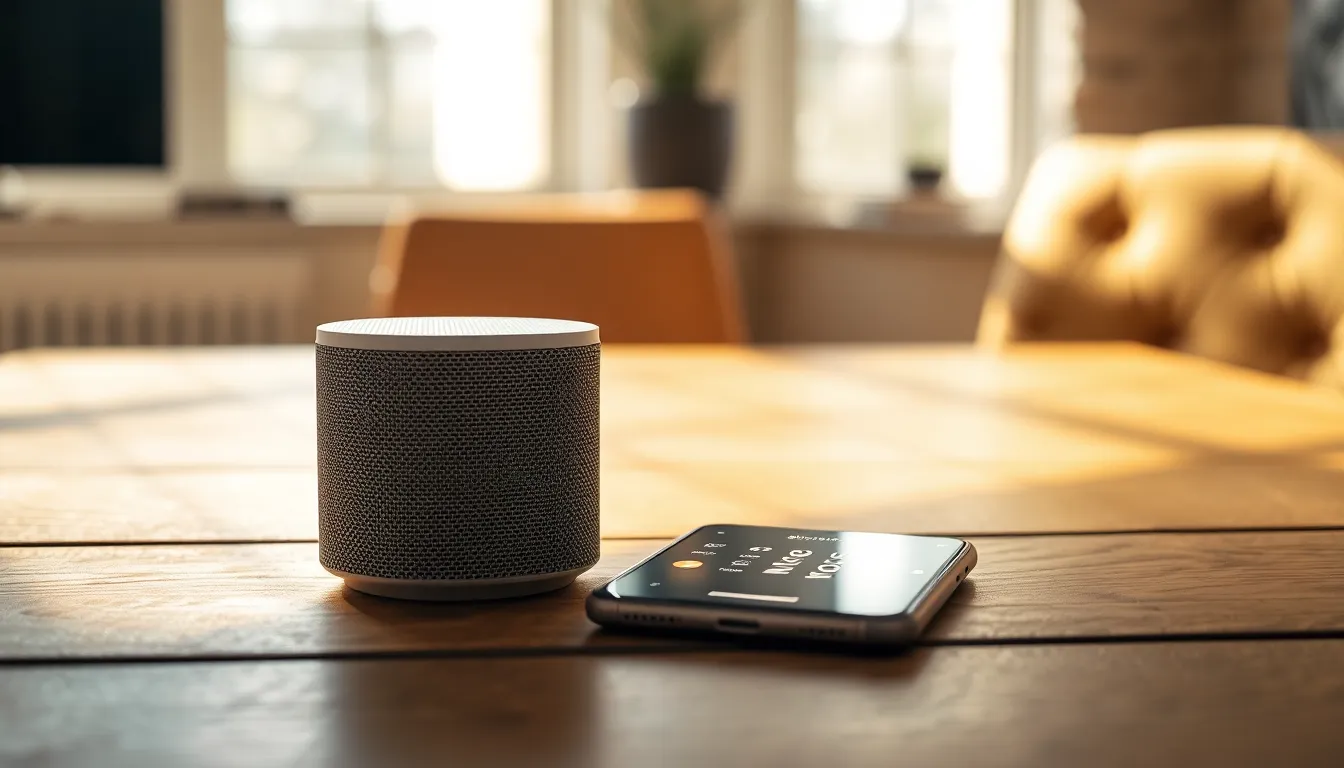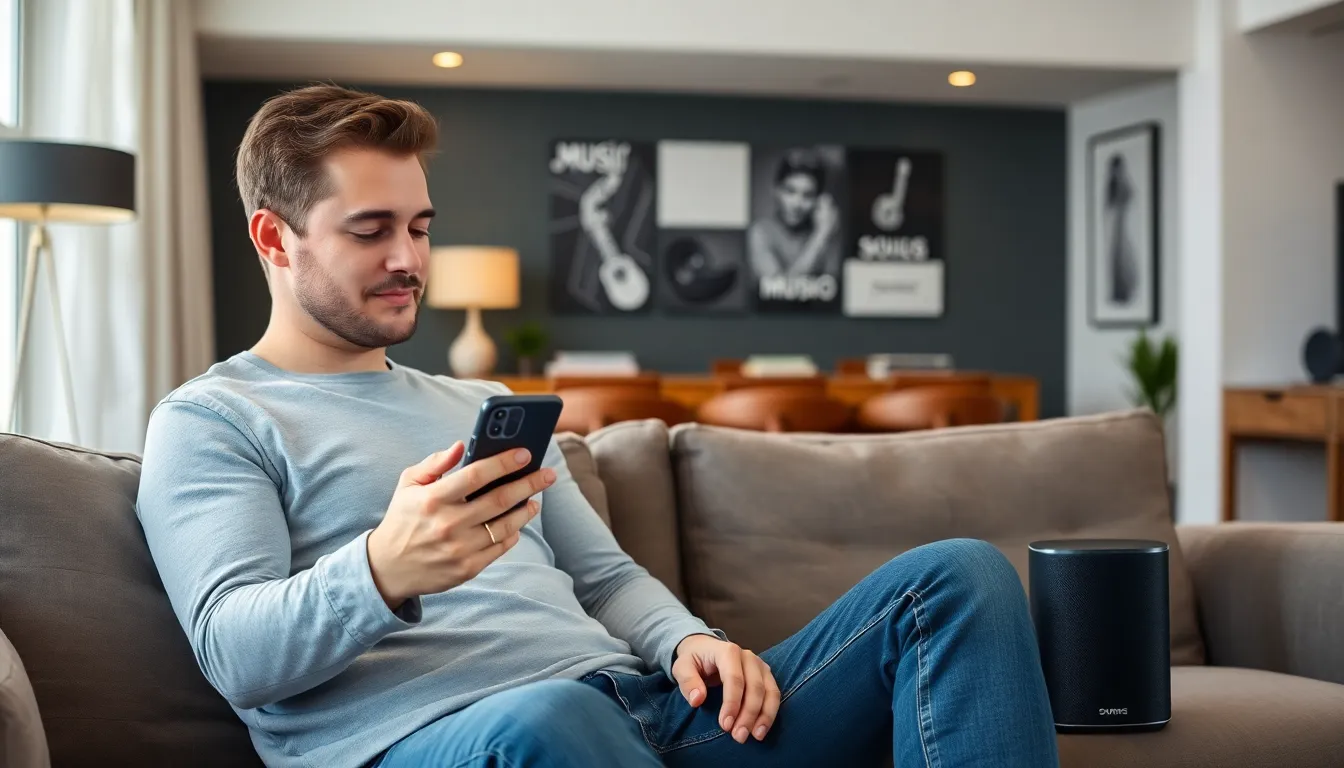Table of Contents
ToggleImagine this: you’ve just unboxed your shiny new Sonos speaker, and the only thing standing between you and a dance party is your iPhone. Connecting them shouldn’t feel like solving a Rubik’s Cube blindfolded. Luckily, it’s easier than it sounds. With a few simple steps, you’ll be blasting your favorite tunes in no time.
Overview of Sonos Speakers
Sonos speakers deliver high-quality sound with a versatile design. Known for their wireless capabilities, these speakers connect seamlessly to Wi-Fi networks, eliminating the need for messy cables. Each model offers unique features catering to diverse preferences.
Multiple models exist within the Sonos lineup, including the Sonos One, Sonos Move, and Sonos Arc. The Sonos One excels in its voice control capabilities, while the Sonos Move combines portability with robust sound. Users can also enjoy immersive audio experiences with the soundbar option, Sonos Arc, ideal for home theater setups.
Sonos speakers integrate effortlessly with various streaming services like Spotify, Apple Music, and Amazon Music. They support different audio formats, ensuring compatibility with users’ preferred content. These speakers also allow for multi-room audio, enabling users to play different songs in separate rooms or sync audio across multiple speakers.
Control options for Sonos speakers include the Sonos app, voice commands, and physical buttons on the devices. The app provides a user-friendly interface, facilitating playlists creation and speaker management. Enjoying music becomes an engaging experience through intuitive controls.
Listening experiences can vary based on placement and room acoustics. Positioning speakers in corners or near walls can enhance sound quality. Users may experiment with different arrangements to find the optimal setup for their space.
Updates and improvements are regular, ensuring Sonos speakers maintain cutting-edge technology. Regular software updates enhance functionality and introduce new features, keeping the devices current. This commitment to improvement solidifies Sonos’ reputation in the audio market.
Preparing Your iPhone

Preparing the iPhone for connecting to a Sonos speaker involves several key steps that ensure seamless integration.
Checking Compatibility
Confirm the iPhone’s compatibility with Sonos speakers. Generally, iPhones running iOS 12 or later support the Sonos app. Verify the Sonos speaker model you own since some features depend on the specific model and iOS version. Check the official Sonos website for updated compatibility lists. Ensuring the iPhone meets compatibility standards helps avoid connection issues.
Updating iOS
Always keep the iPhone’s iOS version up to date. Navigate to the Settings app, select General, and tap Software Update to check for available updates. Installing the latest iOS version enhances functionality and improves the performance of the Sonos app. Support for new features, security enhancements, and bug fixes often comes with updates. It’s crucial to check for updates regularly to maintain optimal performance while using the Sonos speaker.
Downloading the Sonos App
To connect a Sonos speaker to an iPhone, downloading the Sonos app is essential. This app serves as the hub for controlling and managing the speaker’s features.
Installation Steps
First, navigate to the App Store on the iPhone. Searching for “Sonos” brings up the official app, which typically appears at the top of the results. Tapping the download button begins the installation process. The app downloads quickly, and once it’s finished, an open button appears. Opening the app prompts users to follow on-screen instructions for setup and connection to the Wi-Fi network. Ensuring the iPhone remains connected to Wi-Fi throughout this process is crucial for a seamless setup experience.
Creating an Account
Setting up an account is the next step once the app is open. Users can tap “Create Account” on the welcome screen. Entering an email address along with a secure password completes this part of the process. After confirming the email address through a verification link, users gain access to personalized features. Signed-in users can customize playlists, control speaker settings, and manage multiple Sonos speakers easily. Such features enhance the overall music experience, letting individuals enjoy their favorite sounds effortlessly.
Connecting Sonos Speaker to iPhone
Connecting a Sonos speaker to an iPhone is a simple process that enhances the music experience. Two primary methods exist: using Wi-Fi and using Bluetooth.
Using Wi-Fi
Enjoy a seamless connection to a Sonos speaker through Wi-Fi. First, ensure the Sonos speaker is set up and connected to the same Wi-Fi network as the iPhone. Open the Sonos app, and it will automatically search for available speakers. Selecting the desired speaker from the list completes the connection process. Afterward, customizing settings and managing music will become effortless through the app. Multi-room audio capabilities can also enhance listening experiences, allowing users to control music in different rooms simultaneously.
Using Bluetooth
Before connecting via Bluetooth, confirm that the Sonos speaker supports this feature. Activating Bluetooth on the iPhone is essential. Navigate to the Settings app, select Bluetooth, and toggle it on. Next, place the Sonos speaker in pairing mode; this typically involves pressing specific buttons on the speaker itself. Once in pairing mode, the speaker’s name appears on the iPhone under available devices. Tapping the name connects the speaker instantly, enabling users to play audio directly from their device. Adjusting volume and playback through the iPhone is simple and convenient.
Troubleshooting Connectivity Issues
Connectivity issues can disrupt the experience of using Sonos speakers with an iPhone. Identifying common problems first allows for a smoother resolution process.
Common Problems
Users frequently encounter issues such as the Sonos app not detecting the speaker or the iPhone struggling to connect to the Wi-Fi network. Sometimes, the Sonos speaker may be unresponsive during setup, leading to frustration. Interference from other devices on the network also impacts connectivity. An unstable Wi-Fi connection significantly affects the speaker’s performance and decreases audio quality. Additionally, outdated software on either the iPhone or the Sonos app can prevent successful connectivity, causing complications during the setup process.
Solutions and Tips
Maintaining a strong Wi-Fi connection proves essential. Ensure the Sonos speaker and the iPhone connect to the same network for seamless integration. Restarting the router can resolve issues associated with network interference. Updating the Sonos app provides essential fixes and features necessary for optimal performance. Performing a software update on the iPhone also enhances overall compatibility. If problems persist, resetting the Sonos speaker may restore connectivity. Following Sonos’ official support resources offers additional troubleshooting steps for unresolved issues.
Connecting a Sonos speaker to an iPhone is a simple and rewarding process. With the right steps users can enjoy high-quality sound and seamless integration with their favorite music streaming services. Whether using Wi-Fi or Bluetooth the versatility of Sonos speakers enhances any listening experience.
By keeping the iPhone updated and following the setup instructions in the Sonos app users can easily manage their audio preferences. Troubleshooting tips ensure that any connectivity issues are quickly resolved allowing for uninterrupted enjoyment of music throughout the home.
With Sonos speakers users can transform their audio experience and make the most of their iPhone’s capabilities.




